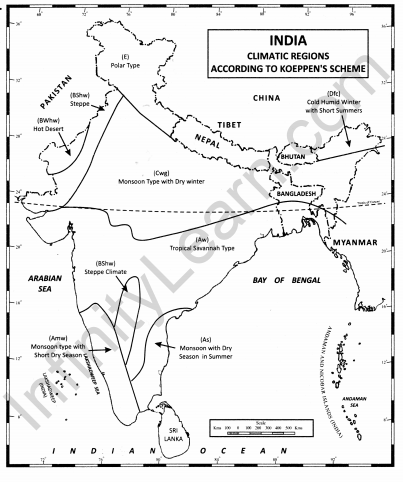Table of Contents
Class 11 Geography NCERT Solutions Chapter 4 Climate
Class 11 Geography Chapter 4 NCERT Textbook Questions Solved.
1. Choose the right answer from the four alternatives given below.
Question 1(i).
What causes rainfall on the coastal areas of Tamil Nadu in the beginning of winters?
(а) South-West monsoon
(b) Temperate cyclones
(c) North-Eastern monsoon
(d) Local air circulation
Answer:
(c) North-Eastern monsoon
Question 1(ii).
What is the proportion of area of India which receives annual rainfall less than 75 cm?’
(a) Half
(b) One-third
(c) Two-third
(d) Three-fourth
Answer:
(d) Three-fourth
Question 1(iii).
Which one of the following is not a fact regarding South India?
(а) Diurnal range of temperature is less here.
(b) Annual range of temperature is less here.
(c) Temperatures here are high throughout the year.
(d) Extreme climatic conditions are found here.
Answer:
(d) Extreme climatic conditions are found here.
Question 1(iv).
Which one of the following phenomenon happens when the sun shines vertically over the Tropic of Capricorn in the southern hemisphere?
(a) High pressure develops over North-western India due to low temperatures.
(b) Low pressure develops over North-western India due to high temperatures.
(c) No changes in temperature and pressure occur in north-western India.
(d) ‘Loo’ blows in the North-western India.
Answer:
(a) High pressure develops over North-western India due to low temperatures.
Question 1(v).
In which of the following states in India do we find ‘As’ type of climate as per Koeppen’s classification?
(a) In Kerala and coastal Karnataka
(b) In Andaman and Nicobar Islands
(c) On Coromandel Coast
(d) In Assam and Arunachal Pradesh
Answer:
(c) On Coromandel Coast
2. Answer the following questions in about 30 words.
Question 2(i).
What are the three important factors which influence the mechanism of Indian weather?
Answer:
The three important factors which influence the mechanism of Indian weather are:
- Distribution of air pressure and winds on the surface of the earth.
- Upper air circulation caused by factors controlling global weather and the inflow of different air masses and jet streams.
- Inflow of western cyclones generally known as disturbances during the winter season and tropical depressions during the south-west monsoon period in India, creating weather conditions favourable for rainfall.
Question 2(ii).
What is the Inter-Tropical Convergene Zone?
Answer:
The Inter Tropical Convergence Zone (ITCZ) is a low pressure zone located at the equator where trade winds converge, and so, it is a zone where air tends to ascend. In July, the ITCZ is located around 20°N-25°N latitudes (over the Gangetic plain). These are sometimes called the monsoon trough. This monsoon trough encourages the development of thermal low over north and northwest India. Due to the shift of ITCZ, the trade winds of the southern hemisphere cross the equator between 40° and 60°E longitudes and start blowing from southwest to northeast due to the Coriolis force. It becomes southwest monsoon. In winter, the ITCZ moves southward, and so the reversal of winds from northeast to south and southwest, takes place. They are called northeast monsoons.
Question 2(iii).
What is meant by ‘bursting of monsoon’? Name the place of India which gets the highest rainfall.
Answer:
High velocity winds with extreme thundering and lightening cause sudden rainfall. It is called bursting of the monsoon. The easterly jet stream sets in along 15°N latitude only after the western jet stream has withdrawn itself from the region. This easterly jet stream is held responsible for the burst of the monsoon in India.
The highest rainfall occurs along the west coast, on the Western Ghats, as well as in the sub-Himalayan areas is the northeast and the hills of Meghalaya. Here the rainfall exceeds 200 cm. In some parts of Khasi and Jaintia hills, the rainfall exceeds 1,000 cm. In the Brahmaputra valley and the adjoining hills, the rainfall is less than 200 cm.
Question 2(iv).
Define ‘climatic region’? What are the bases of Koeppen’s classification?
Answer:
A climatic region has a homogeneous climatic condition which is the result of a combination of factors. Temperature and rainfall are two important elements which are considered to be decisive in all the schemes of climatic classification. Koeppen identified a close relationship between the distribution of vegetation and climate. He selected certain values of temperature and precipitation and related them to the distribution of vegetation and used these values for classifying the climates. Koeppen introduced the use of capital and small letters to designate climatic groups and types. Koeppen recognised five major climatic groups, four of them are based on temperature and one on precipitation.
- Tropical climates,
- Dry climates,
- Warm temperate climates,
- Cool temperate climates,
- Ice climates
Question 2(v).
Which type(s) of cyclones cause rainfall in north-western India during winter? Where do they originate?
Answer:
Western cyclonic disturbance cause rainfall in north western India during winter. The western cyclonic disturbances which enter the Indian subcontinent from the west and the north-west during the winter months originate over the Mediterranean Sea and are brought into India by the westerly jet stream. An increase in the prevailing night temperature generally indicates an advance in the arrival of these cyclones disturbances.
3. Answer the following questions in not more than 125 words.
Question 3(i).
Notwithstanding the broad climatic unity, the climate of India has many regional variations. Elaborate this statement giving suitable examples.
Answer:
The monsoon regime emphasises the unity of India with the rest of south-east Asian region. This view of broad unity of the monsoon type of climate should not, however, lead one to ignore its regional variations which differentiate the weather and climate of different regions of India. The climate of Kerala and Tamil Nadu in the south is so different from that of Uttar Pradesh and Bihar in the north, and yet all of these have a monsoon type of climate.
1.While in the summer the mercury occasionally touches 55°C in the western Rajasthan, it drops down to as low as minus 45°C in winter around Leh. Churu in Rajasthan may record a temperature of 50°C or more on a June day while the mercury hardly touches 19°C in Tawang (Arunachal Pradesh) on the same day.
2. On a December night, temperature in Drass (Jammu and Kashmir) may drop down to minus 45°C while Thiruvananthapuram or Chennai on the same night records 20°C or 22°C.
3. In Kerala and in the Andaman Islands, the difference between day and night temperatures may be hardly seven or eight degree Celsius. But in the Thar desert, if the day temperature is around 50°C, at night, it may drop down considerably upto 15°-20°C.
4. While snowfall occurs in the Himalayas, it only rains over the rest of the country. Similarly, variations are noticeable not only in the type of precipitation but also in its amount. While Cherrapunji and Mawsynram in the Khasi Hills of Meghalaya receive rainfall over 1,080 cm in a year, Jaisalmer in Rajasthan rarely gets more than 9 cm of rainfall during the same period.
5. Tura situated in the Garo Hills of Meghalaya may receive an amount of rainfall in a single day which is equal to 10 years of rainfall at Jaisalmer. While the annual precipitation is less than 10 cm in the north-west Himalayas and the western deserts, it exceeds 400 cm in Meghalaya.
6. The Ganga delta and the coastal plains of Orissa are hit by strong rain-bearing storms almost every third or fifth day in July and August while the Coromandal coast, a thousand km to the south, goes generally dry during these months. Most parts of the country get rainfall during June-September, but on the coastal areas of Tamil Nadu, it rains in the beginning of the winter season.
These examples confirm that there are seasonal variations in temperature from place to place and from region to region in India. In spite of these differences and variations, the climate of India is monsoonal in rhythm and character.
Question 3(ii).
How many distinct seasons are found in India as per the Indian Meteorological Department? Discuss the weather conditions associated with any one season in detail.
Answer:
In India as per the Indian Meteorological Department, there are four distinct seasons:
- Winter Season (from December to February)
- Summer Season (from March to May)
- South west monsoon season (from June to September)
- Retreating Monsoon (from October to November)
Summer Season: April, May and June are the months of summer in north India.
In most parts of India, temperatures recorded are between 30°-32°C. In March, the highest day temperature of about 38°C occurs in the Deccan Plateau while in April, temperature ranging between 38°C and 43°C are found in Gujarat and Madhya Pradesh. In May, the heat belt moves further north, and in the north-western part of India, temperatures around 48°C are not uncommon.
The hot weather season in south India is mild and not too intense as found in north India. The Peninsular situation of south India with moderating effect of the oceans keeps the temperatures lower than that prevailing in north India. Therefore, temperatures remain between 26°C and 32°C. Due to altitude, the temperatures in the hills of Western Ghats remain below 25°C. In the coastal regions, temperature does not decrease from north to south rather it increases from the coast to the interior. The mean daily minimum temperature during the summer months also remains quite high and rarely goes below 26°C. ”
Project/Activity
On the outline map of India, show the following:
- Areas of winter rain
- Wind direction during the summer season
- Areas having variability of rainfall over 50 per cent
- Areas having less than 15°C temperature in January
- Isohyte of 100 cm.
Answer:
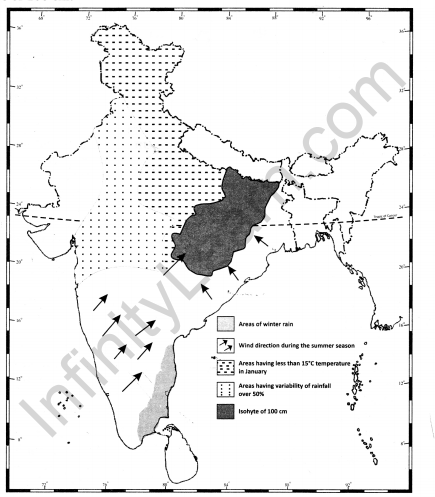
Class 11 Geography Chapter 4 NCERT Extra Questions
Class 11 Geography Chapter 4 Multiple Choice Questions
Question 1.
The winds blow across the Asian continent at latitudes north of the Himalayas roughly parallel to the Tibetan highlands. These are known as what?
(a) Monsoon bursting
(b) Western cyclones
(c) Jet streams
(d) Monsoon winds
Answer:
(c) Jet streams
Question 2.
The sudden onset of the moisture-laden winds associated with violent thunder and lightning is often termed as what?
(a) Bursting of monsoon
(b) Western cyclones
(c) Jet streams
(d) Monsoon winds
Answer:
(a) Bursting of monsoon
Question 3.
Highest rainfall takes place in India at:
(a) Mawsynram
(b) Eastern Coast
(c) Gaya
(d) Bhabhar
Answer:
(a) Mawsynram
Question 4.
Which of the following is most humid region of India?
(a) Northeast India and Western coast
(b) Ladhakh region
(c) Coastal regions of Tamil Nadu
(d) Rann of Kachchh
Answer:
(a) Northeast India and western coast
Question 5.
What are the bases of Koeppen’s classification?
(a) On the basis of latitude and longitude
(b) On the basis of winds and pressure
(c) On the basis of temperature and precipitation
(d) On the basis of local weather conditions
Answer:
(c) On the basis of temperature and precipitation
Question 6.
In Assam, nor westers storms are known as what?
(a) Kalbaisakhi
(b) Western Cyclone
(c) Bardoli Chheerha
(d) Amravati
Answer:
(c) Bardoli chheerha
Question 7.
What is the position of southern branch of jet streams?
(a) 35° S latitude .
(b) 25° N latitude
(c) 15° N latitude
(d) 25° S latitude
Answer:
(c) 15° N latitude
Question 8.
How much average rainfall is received by Mawsynram?
(a) 1020 cm
(b) 1050 cm
(c) 1080 cm
(d) 1000 cm
Answer:
(c) 1080 cm
Question 9.
What do we call when monsoon withdraws itself?
(а) Retreating monsoon
(b) Bursting of monsoon
(c) Western cyclone
(d) Bardoli chheerha
Answer:
(a) Retreating monsoon
Question 10.
Which season is there during September to December?
(a) Winter season
(b) Retreating monsoon
(c) Summer season
(d) Rainy season
Answer:
(b) Retreating monsoon
Question 11.
In which regions of India does mango shower take place?
(a) Bihar and Uttar Pradesh
(b) Kerala and Coastal Karnataka
(c) Orissa and West Bengal
(d) Punjab and Haryana
Answer:
(b) Kerala and coastal Karnataka
Question 12.
Which crops grow as a result of blossom shower?
(a) Cotton
(b) Coffee
(c) Jute
(d) Cashew
Answer:
(b) Coffee
Question 13.
In which regions of India do we experience cyclones?
(a) In eastern coastal regions
(b) In western coastal regions
(c) In northern plains
(d) In west India
Answer:
(a) In eastern coastal region
Class 11 Geography Chapter 4 Very Short Answer Type Questions
Question 1.
What do you mean by the word “Monsoon’?
Answer:
It is derived from the Arabic word Mausim meaning Season. Monsoon connotes the climate associated with seasonal reversal in the direction of winds.
Question 2.
Explain two factors helpful in affecting Indian Monsoon.
Answer:
Two factors helpful in Indian monsoon are:
- Jet stream winds
- Difference in atmospheric pressure.
Question 3.
Name two important seasons of Indian climate.
Answer:
Two important seasons of Indian climate are:
- North-west monsoon
- South-east monsoon
Question 4.
Name the seasons of India of sankranti time with months. .
Answer:
- Summer Season (March to May)
- Winter Season (December to February)
Question5.
What is a jet stream?
Answer:
The winds that blow across the Asian continent at latitudes north of the Himalayas roughly parallel to the Tibetan highlands are called jet stream.
Question 6.
What is break in monsoon?
Answer:
During the south-west monsoon period after having rains for a few days, if rain fails to occur for one or more weeks, it is known as break in the monsoon.
Question 7.
Winter monsoons do not cause rainfall as they move from land to the sea. Why?
Answer:
It is because of two reasons: Firstly, they have little humidity; and Secondly, due to anti cyclonic circulation on land, the possibility of rainfall from them reduces.
Question 8.
What is the direction of winds in Kerala during retreating monsoon?
Answer:
The direction of winds in Kerala during retreating monsoon is from north to east and from east to west.
Question 9.
What is the difference between loo and chilled wave?
Answer:
Hot, dry and oppressing winds blowing in the Northern plains from Punjab to Bihar with higher intensity between Delhi and Patna are called loo. When temperature falls too much in northern plains, then winds blowing in these regions are called chilled wave.
Question 10.
Which formula is used to measure variability in rainfall?
Answer:
imageee
Question 11.
Where is polar climate found in India?
Answer:
In India polar climate is found in upper portion of Himalayas which is located 4000 metre above sea level.
Question 12.
Name the most comfortable places of India during winter season.
Answer:
Coastal areas and South India are most comfortable places during winter season.
Question13.
Name most humid regions of India.
Answer:
The most humid regions of India are south east India and Western Ghats.
Question 14.
What is mango shower?
Answer:
Towards the end of summer, there are pre-monsoon showers which are a common phenomena in Kerala and coastal areas of Karnataka. They are known as mango showers, locally since they help in the early ripening of mangoes.
Question 15.
What are western cyclones?
Answer:
The western cyclonic disturbances enter the Indian subcontinent from the west and the north-west during the winter months. It originate over the Mediterranean Sea and are brought into India bv the westerly jet stream.
Question 16.
What is meant by bursting of monsoon?
Answer:
The sudden onset of the moisture-laden winds associated with violent thunder and lightning is often termed as the ‘break’ or ‘burst” of the monsoon.
Question 17.
Why do the Tamil Nadu coast remains dry during south-west monsoon?
Answer:
- The Tamil Nadu coast is situated parallel to the Bay of Bengal branch of southwest monsoon.
- It lies in the rain shadow area of the Arabian Sea branch of the south-west monsoon.
Question 18.
What is meant by October-heat’?
Answer:
The retreating south-west monsoon season is marked by clear skies and rise in temperature. The land is still moist. Owing to the condition of high temperature and humidity, the weather becomes rather oppressive and this is known as the October-heat.
Question 19.
Where do tropical cyclones originate? Which states do they hit the most?
Answer:
Tropical cyclones originate over the Bay of Bengal and the Indian Ocean. These tropical cyclones have very high wind velocity and heavy rainfall and hit the Tamil Nadu, Andhra Pradesh and Orissa coast. Most of these cyclones are very destructive due to high wind velocity and torrential rain that accompanies it.
Question 20.
Name the areas receiving rainfall from South-east monsoon.
Answer:
Only coastal areas of Tamil Nadu receive rainfall from South-east monsoon.
Question 21.
What are important features of Kalbaisakhi.
Answer:
These are dreaded evening thunderstorms in Bengal and Assam. Their notorious nature can be understood from the local nomenclature of ‘Kalbaisakhi’. It is a calamity of the month of Baisakh.
Question 22.
What is El-Nino?
Answer:
EI-Nino is a complex weather system that appears once every three to seven years, bringing drought, floods and other weather extremes to different parts of the world.
Question23.
Give the climatic classification given by Koeppen.
Answer:
Koeppen recognised five major climatic groups, four of them are based on temperature and one on precipitation.
- Tropical climates,
- Dry climates,
- Warm temperate climates,
- Cool temperate climates,
- Ice climates
Question 24.
Which two branches in the Bay of Bengal branch split into?
Answer:
- The Western Branch.
- The North-east Branch.
Question 25.
What is the nature of rainfall received from the Western Branch?
Answer:
The amount of rainfall decreases from east to west.
Question 26.
What type of rainfall does the North-east Branch cause?
Answer:
Heavy rainfall.
Question 27.
Where does the heaviest rainfall of the World occur?
Answer:
At Mawsynram, 1080 cm.
Question 28.
What are the basic features of the Monsoon?
Answer:
Irregularity, uncertainty, unevenness and unreliability.
Question 29.
In which months does the Monsoon retreat?
Answer:
From mid-September to November.
Question 30.
When does the Monsoon leave the Northern Plains?
Answer:
In October.
Question 31.
Where does the low pressure area develop during November?
Answer:
On the Bay of Bengal.
Question 32.
Where do the cyclones cause rainfall in November?
Answer:
On the Eastern coasts of the Peninsular India.
Question 33.
Mention the two heaviest rainfall areas of the country.
Answer:
- The windward slopes of the Western Ghats.
- The Meghalayas Plateau.
Question 34.
Which three regions receive less amounts of rainfall in India?
Answer:
- Western Rajasthan.
- Interior parts of the Peninsular Plateau.
- Ladakh Region.
Question 35.
Which regions of India experience snowfall regularly?
Answer:
The Himalayan lofty mountain ranges.
Class 11 Geography Chapter 4 Short Answer Type Questions
Question 1.
Explain the characteristics of monsoonal rainfall in India.
Answer:
- Rainfall received from the south-west monsoons is seasonal is character, which occurs between June and September.
- The monsoon rainfall has a declining trend with increasing distance from the sea. Kolkata receives 119 cm during the south-west monsoon period, Patna 105 cm, Allahabad 76 cm and Delhi 56 cm.
- The summer rainfall comes in a heavy downpour leading to considerable runoff and soil erosion.
- Monsoon play a pivotal role in the agrarian economy of India because over three-fourth of the total rain in the country is received during the south-west monsoon season.
- Its spatial distribution is also uneven which ranges from 12 cm to more than 250 cm.
- The beginning of the rains sometimes is considerably delayed over the whole or a part of the country.
Question 2.
What is meant by break in the monsoon? Give features of hot weather season.
Answer:
During the south-west monsoon period after having rains for a few days, if rain fails to occur for one or more weeks, it is known as break in the monsoon.
Features of hot weather season are:
- With the apparent-northward movement of the sun towards the tropic of cancer in March, temperature starts rising in north India.
- April, May and June are the months of summer in North India.
- The hot weather season in south India is mild and not so intense as found in North India.
- Because of the heating of the subcontinent, the ITCZ moves northwards occupying a position centered at 25°N in July.
- Roughly, this elongated low pressure monsoon trough extends over the Thar Desert in the north-west to Patna and Chota Nagpur Plateau in the east-south east.
- In the heart of ITCZ in the northwest, the dry and hot winds known as ‘loo’ blow in the afternoon and very often, they continue to well into midnight.
- Dust storms in the evening are very common during May in Punjab, Haryana, eastern Rajasthan and Uttar Pradesh.
Question 3.
What are features of El-Nino?
Answer:
EI-Nino is a complex weather system that appears once every three to seven years, bringing drought, floods and other weather extremes to different parts of the world.
Features:
- The system involves oceanic and atmospheric phenomena with the appearance of warm currents off the coast of Peru in the Eastern Pacific and affects weather in many places including India.
- EI-Nino is merely an extension of the warm equatorial current which gets replaced temporarily by cold Peruvian current or Humbolt current.
- This current increases the temperature of water on the Peruvian coast by 10°C. id) This results in:
- The distortion of equatorial atmospheric circulation;
- Irregularities in the evaporation of sea water;
- Reduction in the amount of planktons which further reduces the number of fish in the sea.
Question 4.
Why India gets a monsoon named as south-west monsoon?
Answer:
- The low pressure conditions by early June are powerful enough to attract the trade winds of Southern Hemisphere coming from the Indian Ocean.
- These South-east trade winds cross the Equator and enter the Bay of Bengal and the Arabian sea, only to be caught up in the air circulation over India.
- Passing over the equatorial warm currents they bring with them moisture in abundance.
- After crossing the equator, they follow south westerly directions and they are known as south-west monsoon.
Question 5.
Enumerate the factors that influence the climate of the Subcontinent of India.
Answer:
- Relief
- Latitude
- Altitude
- Pressure and wind systems: This in turn depends on:
- Trade winds.
- Western disturbances.
- Jet stream,
- Distance from the sea
- Ocean currents.
Question 6.
Differentiate between South-west monsoon and Retreating monsoon.
Answer:
| Basis | Weather | Climate |
| Time
Reference |
Weather is the momentary state of the atmosphere. | Climate refers to the average of the weather conditions over a longer period of time. |
| Time | Weather changes quickly, may be within a day or week. | Climate changes imperceptively and may be noted after 50 years or even more. |
| Frequency | Frequency of weather change can be many times a day. | Frequency of climate change is a very long process and can’t be seen so easily. |
Question 7.
Differentiate between the South-West Monsoon and Retreating Monsoon.
Answer:
The differences between the South-West Monsoon and Retreating Monsoon:
| Basis | South-West Monsoon | Retreating Monsoon |
| Timing | These winds blow from June to September. | These winds blow during October and November. |
| Direction | The direction of these winds is from West to the North East. | These winds are calm. These flow from North to South. |
| Rainfall | During these months South West Monsoons cover the whole of India and give heavy rainfall. The humidity is high. The pressure is low on the land area. | The temperature increases again, the land being covered with rainy water, the humidity becomes high. The temperature goes up. The coastal areas of Tamil Nadu receive maximum rainfall from these retreating winds. |
Class 11 Geography Chapter 4 Long Answer Type Questions
Question 1.
Explain the important features of Winter Season of India.
Answer:
By October, the rainy season comes to an end all over the country and the days become short and the night become long. The rays of the sun are not overhead. The air turns cooler in the plains marking the coming of the winter season.
The winter season lasts from November to February every year. In the Northern Plains, very cold wind blow making the winter months severe. December and January are the coldest months in the northern plain. The mean daily temperature remains below 21°C over most parts of northern India.
Most of the hilly areas receive heavy snowfall. January is the coldest month in the Northern Plains. The winter season in Peninsular India is mild as a result of the influence of the surrounding water bodies. The coromandel Coast receives heavy rainfall during this season.
The desert is cool during the day but cold at night. The air starts warming up in the month of March, and the weather is neither cold nor hot. This time of early summer is also called the spring season. Every part of our country regularly experiences this cycle of seasons.
Question 2.
According to Koeppen, in how many groups- can you classify the climate of India?
Answer:
Koeppen identified a close relationship between the distribution of vegetation and climate. He selected certain values of temperature and precipitation and related them to the distribution of vegetation and used these values for classifying the climates. Koeppen introduced the use of capital and small letters to designate climatic groups and types. Koeppen recognised five major climatic groups, four of them are based on temperature and one on precipitation.
- Tropical climates,
- Dry climates,
- Warm temperate climates,
- Cool temperate climates,
- Ice climates
Classification of Indian climatic regions: Amw – Monsoon with short dry season.
Areas: West coast of India south of Goa
As – Monsoon with dry summer
Areas: Coromandel coast of Tamil Nadu
Aw – Tropical savannah.
Areas: Most of the Peninsular plateaus, south of the Tropic of Cancer
Bwhw – Semi-arid steppe climate.
Areas: North-western Gujarat, some parts of western Rajasthan and Punjab
Bwhw – Hot desert. Areas: Extreme western Rajasthan
Cwg – Monsoon with dry winter.
Areas: Ganga plain, eastern Rajasthan, northern Madhya Pradesh, most of North-east India
Dfc – Cold humid winter with short summer.
Areas: Arunachal Pradesh
E – Polar type. Areas: Jammu and Kashmir, Himachal Pradesh and Uttarakhand.
Question 3.
Explain the spatial variation in the rainfall throughout the country.
Answer:
There is great variation in rainfall throughout the country.
- While Cherrapunji and Mawsynram in the Khasi Hills of Meghalaya receive rainfall over 1,080 cm in a year, Jaisalmer in Rajasthan rarely gets more than 9 cm of rainfall during the same period.
- Tura situated in the Garo Hills of Meghalaya may receive an amount of rainfall in a single day which is equal to 10 years of rainfall at Jaisalmer. While the annual precipitation is less than 10 cm in the north-west Himalayas and the western deserts, it exceeds 400 cm in Meghalaya.
- The highest rainfall occurs along the west coast, on the western Ghats as well as in the sub-Himalayan areas in the north-west and the hills of Meghalaya, rainfall exceeding 200 cm. In some parts of Khasi and Jaintia hills, the rainfall exceeds 1,000 cm. In the Brahmaputra valley and the adjoining hills, the rainfall is less than 200 cm.
- Rainfall between 100-200 cm is received in southern parts of Gujarat, east Tamil Nadu, North-eastern Peninsular covering Orissa, Jharkhand, Bihar, eastern Madhya Pradesh, Northern Ganga Plain along the sub-Himalayas and the Cachar valley and Manipur.
- Western Uttar Pradesh, Delhi, Haryana, Punjab, Jammu and Kashmir, eastern Rajasthan, Gujarat and Deccan Plateau receive rainfall between 50-100 cm.
Question 4.
Explain the spatial variation in temperature in India.
Answer:
India has hot monsoonal climate which is the prevalent climate in south and south-east Asia.
- While in the summer the mercury occasionally touches 55°C in the western Rajasthan, it drops down to as low as minus 45°C in winter around Leh.
- Churu in Rajasthan may record a temperature of 50°C or more on a June day while the mercury hardly touches 19°C in Tawang (Arunachal Pradesh) on the same day.
- On a December night, temperature in Drass (Jammu and Kashmir) may drop down to minus 45°C while Thiruvananthapuram or Chennai on the same night records 20°C or 22°C.
- In Kerala and in the Andaman Islands, the difference between day and night temperatures may be hardly seven or eight degree Celsius. But in the Thar desert, if the day temperature is around 50°C, at night, it may drop down considerably upto 15°-20°C.
- While snowfall occurs in the Himalayas, it only rains over the rest of the country. Similarly, variations are noticeable not only in the type of precipitation but also in its amount.
Question 5.
How economic life in India is affected by monsoon?
Answer:
Economic life of India is extremely affected by the monsoon.
- Monsoon is that axis around which revolves the entire agricultural cycle of India. Around 64 % people of India depend on agriculture for their livelihood and agriculture itself is based on south-west monsoon.
- Except Himalayas all the parts of the country have temperature above the threshold level to grow the crops or plants throughout the year.
- Regional variations in monsoon climate help in growing various types of crops.
- Variability of rainfall brings droughts or floods every year in some parts of the country.
- Agricultural property of India depends very much on timely and adequately distributed rainfall. If it fails, agriculture is adversely affected particularly in those regions where means of irrigation are not developed.
- Sudden monsoon burst creates problems of soil erosion over large areas in India.
- Winter rainfall by temperate cyclones in north India is highly beneficial for Rabi crops.
- Regional climatic variation in India is reflected in the vast variety of food, clothes and house types.
Question 6.
What is Global Warming? What are the effects of Global Warming?
Answer:
Due to global warming the polar ice caps and mountain glaciers would melt and the amount of water in the ocean would increase. It leads to rise in the sea level and melting of glaciers and sea-ice due to warming.
Effects:
- Sea level will rise 48 cm by the end of twenty first century.
- Increase the incidence of annual flooding.
- Insect-borne diseases like malaria, and leads to shift in climatic boundaries, making some regions wetter and other dries.
- Agricultural pattern would shift and human population as well as the ecosystem would experience change.
- The peninsular India would be submerged.
- Global warming refers to the increase in average ground temperatures refers to the increase in average ground temperatures on earth. These higher temperatures across the planet are caused by an intensification of the greenhouse effect.
Question 7.
What is Break in Monsoon? What are its causes? When is the monsoon expected to break in Kerala and reach the plains of Punjab?
Answer:
During the south-west monsoon period after having rains for a few days, if rain fails to occur for one or more weeks, it is known as break in the monsoon. These dry spells are quite common during the rainy season. These breaks in the different regions are due to different reasons:
- In northern India rains are likely to fail if the rain-bearing storms are not very frequent along the monsoon trough or the ITCZ over this region.
- Over the west coast the dry spells are associated with days when winds blow parallel to the coast.
Breaking of Monsoon:
- Breaking of the Monsoon in Kerala: Beginning of June.
- Reaching Punjab: First week of July.
Class 11 Geography Chapter 4 HOTS Questions
Question 1.
Give reasons for the following:
- Northwest India gets rainfall even in winter season.
- In Tamil Nadu, more rainfall takes place in winter season as compared to summer season.
- Very less rainfall occurs in Rajasthan.
- In winter season there is high atmospheric pressure in Northwest part of India.
- In North west monsoon the winds of Gangetic plains flow from west to east.
- Highest rainfall occurs in Mawsynram and Cherrapunji.
- Temperature range of Delhi is more than Mumbai.
- Temperature falls in winter season in north India.
Answer:
1. In northwestern India, some weak temperate cyclones from the Mediterranean sea cause rainfall in Punjab, Haryana, Delhi and western Uttar Pradesh. Although the amount is meagre, it is highly beneficial for rabi crops. The precipitation is in the form of snowfall in the lower Himalayas. It is this snow that sustains the flow of water in the Himalayan rivers during the summer months. The precipitation goes on decreasing from west to east in the plains and from north to south in the mountains.
2. The coasts of Tamil Nadu or Chennai coasts have more than 5 cm of rainfall in winter. It is because the North-east monsoon winds passing over the Bay of Bengal get moisture and when they reach the Tamil Nadu coasts they cause rainfall here.
3. Moving along the Narmada and Tapi river valleys, monsoon winds along the Arabian Sea cause rainfall in extensive areas of central India. The Chota Nagpur plateau gets 15 cm rainfall from this part of the branch. Thereafter, they enter the Ganga plains and mingle with the Bay of Bengal branch. When this monsoon wind strikes the Saurashtra Peninsula and the Kachchh. It then passes over west Rajasthan and along the Aravalis, causing only a scanty rainfall because these winds are no wetter.
4. In south India, the air pressure is slightly lower. The isobars of 1019 mb and 1013 mb pass through north-west India and far south, respectively. As a result, winds start blowing from north-western high pressure zone to the low air pressure zone over the Indian Ocean in the south. Due to low pressure gradient, the light winds with a low velocity of about 3-5 km per hour begin to blow outwards. By and large, the topography of the region influences the wind direction.
5. By and large, the topography of the region influences the wind direction. They are westerly or north-westerly down the Ganga Valley. They become northerly in the Ganga-Brahmaputra delta. Free from the influence of topography, they are clearly north-easterly over the Bay of Bengal. During the winters, the weather in India is pleasant. The pleasant weather conditions, however, at intervals, get disturbed by shallow cyclonic depressions originating over the east Mediterranean Sea and travelling eastwards across West Asia, Iran, Afghanistan and Pakistan before they reach the north-western parts of India. On their way, the moisture content gets augmented from the Caspian Sea in the north and the Persian Gulf in the south.
6. It is covered with three hills Garo, Khasi and Jantia. Being covered from hills from three sides, due to which winds once enter can’t leave this region. They strike with mountains and cause rainfall. Therefore, Mawsynram and Cherrapunji have highest rainfall.
7. Range of temperature is low in areas which are near to sea and high in areas which are far off from the sea. Delhi is far off from the sea and Mumbai is near to sea. Therefore, temperature range of Delhi is more than Mumbai.
8. There are three main reasons for the excessive cold in north India during this season :
- States like Punjab, Haryana and Rajasthan being far away from the moderating influence of sea experience continental climate.
- The snowfall in the nearby Himalayan ranges creates cold wave situation;
- Around February, the cold winds coming from the Caspian Sea and Turkmenistan bring cold wave along with frost and fog over the north-western parts of India.
Question 2.
Explain the meaning of advancing monsoon and retreating of monsoon.
Answer:
The season when rainy season begins in India, it is called advancing monsoon. It starts from Bay of Bengal and Arabian sea. The season of retreating monsoon is the period of Transition. During the period of transition low pressure of the north-west shifts to the Bay of Bengal. It results in the formation of cyclones over the Bay of Bengal. These cyclones cause havoc on the coasts of Orissa and Andhra Pradesh.
Question 3.
Which areas have more than 50 cm and less than 5 cm of rainfall in July? Why is it so?
Answer:
Most areas of the country have more than 50 cm of rainfall in July. The western Rajasthan (Thar Desert) and the North-eastern Ladakh experience less than 5 cm. of rainfall in July. Due to parallel situated of Aravalis, lack of vegetation, high temperatures and non-condensation of moisture in western Rajasthan rainfall is very scanty. The Zaskar range does not allow the monsoon winds to reach North-eastern Ladakh. Hence it also receives very scanty rainfall during July.
Question 4.
How have the easterlies assumed the name ‘Trade’?
Answer: The word ‘Trade’ has been derived from the German world ‘Track’. Track means the path on which winds blow in the same direction throughout the year and on the same course. The easterlies characterise these qualities. Hence, they have assumed the name ‘trade’.
Question 5.
Why does Shillong receive more rainfall than Calcutta (Kolkata)? Give two reasons.
Answer:
Shillong is situated on the Meghalaya Plateau which receives the highest rainfall in the country.
- Shillong is situated on lofty mountains, funnel shaped. Here condensation is intense causing heavy rainfall.
- Kolkata is located on the Ganga- Brahmaputra Delta. There is no mountain range obstructing the South west monsoon. Hence, it receives less rainfall.
Question 6.
What is annual range of temperature? Explain it by giving one example.
Answer:
The difference between the maximum average temperature and minimum average temperature of a place over twelve months is known as annual range of temperature.
Example:
The maximum average temperature at Jodhpur is 33.9°C and minimum, average temperature is 14.9°C. Hence the annual range of temperature at Jodhpur is 19°C (33.9°C – 14.9°C).
Question 7.
What is extreme climate? Name two places of extreme climate in India.
Answer:
Extreme Climate:
The climate which has high annual range of temperature and great variation in the amount of rainfall over the year is known as extreme climate. It is also called continental or interior climate as it is found in the interior parts of the continents.
For examples, Jodhpur, Delhi and Kanpur.
Question 8.
Why does rainfall on the Western Ghats decrease from south to north?
Answer:
Rainfall on the Western Ghats decreases from south to north because the height of the Western Ghats in the south is maximum and it goes on decreasing northwards allowing progressively less condensation. It results in the decrease of rainfall from south to north. More over the period of onset and withdrawal of monsoon in south is more than that in the north. It results in more rainfall in southern parts than in the northern parts of the Western Ghats.
Class 11 Geography Chapter 4 Value Based Questions
Question 1.
“Monsoon is a gambling for Indian farmers.” Explain
Answer:
Agricultural property of India depends very much on timely and adequately distributed rainfall. If it fails, agriculture is adversely affected particularly in those regions where means of irrigation are not developed. Monsoon is that axis around which revolves the entire agricultural cycle of India. Around 64% people of India depend on agriculture for their livelihood and agriculture itself is based on south-west monsoon. Except Himalayas all the parts of the country have temperature above the threshold level to grow the crops or plants throughout the year. Regional variations in monsoon climate help in growing various types of crops. Variability of rainfall brings droughts or floods every year in some parts of the country.
Question 2.
“In spite of abundant rainfall, India is a water thirsty land”. Why is it so?
Answer:
India is a water thirsty land in spite of abundant rainfall. This is because of the following factors:
- Occurrence of rainfall in a few months (from June to September).
- Rapid run off and the quick evaporation of rainwater.
- Long breaks and delays in the Monsoons.
Map Skills
Question 1.
Locate on an outline map of India, Eastern jet stream.
Answer:
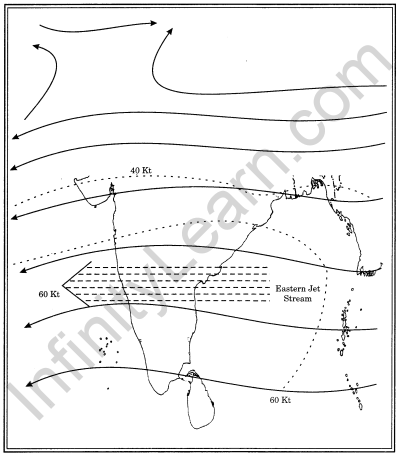
Question 2.
Locate on an outline map of India, normal dates of onset of southwest monsoon in different states of India.
Answer:

Question 3.
Locate on an outline map of India, isotherms in India in January and July.
Answer:
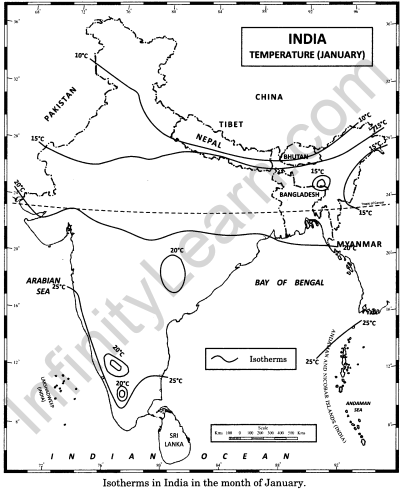
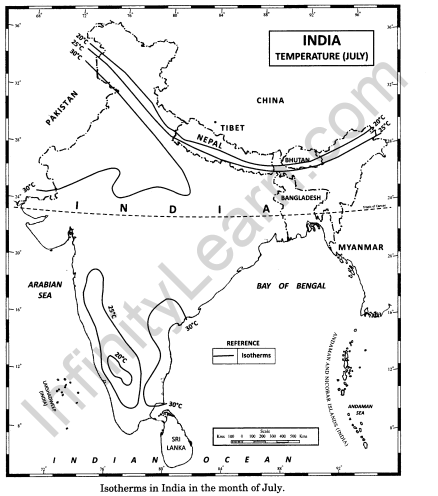
Question 4.
Locate on an outline map of India, Isobars and direction of winds in India in January and July.
Answer:

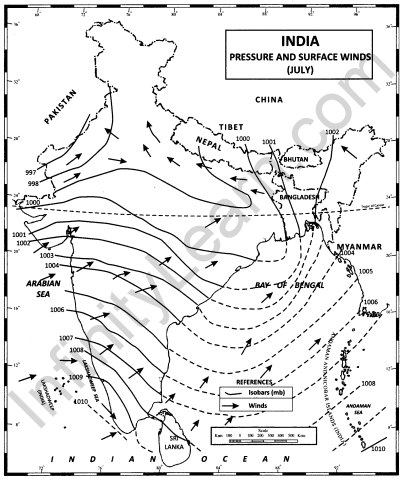
Question 5.
Locate on an outline map of India, annual rainfall in different states of India.
Answer:

Question 6.
Locate on an outline map of India, Seasonal rainfall (June-September) in different states of India
Answer:
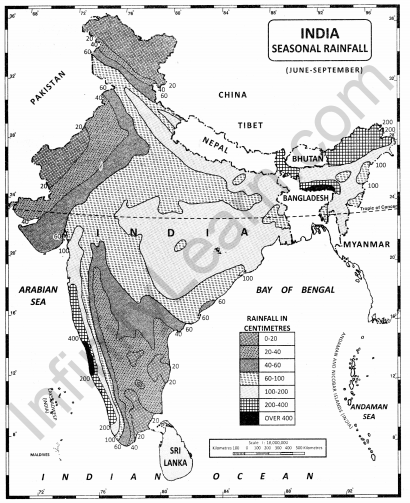
Question 7.
Locate on an outline map of India, different climatic regions of India as per Koeppen’s classification.
Answer:
